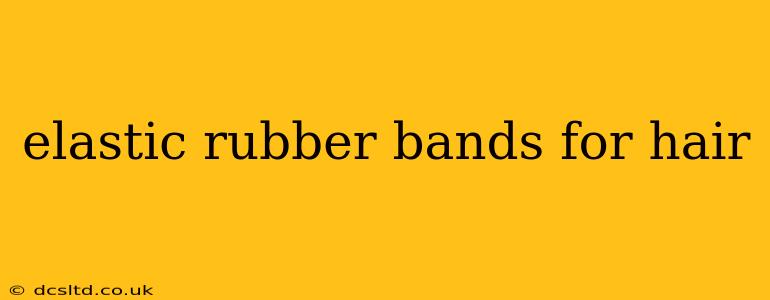Elastic hair bands are a ubiquitous hair accessory, offering a versatile and convenient way to style and manage hair. But with so many options available, choosing the right elastic rubber band can feel overwhelming. This guide explores the different types, benefits, and considerations when selecting elastic rubber bands for your hair.
What are the Different Types of Elastic Hair Bands?
The market offers a surprising variety of elastic hair bands, each with its own unique characteristics:
-
Traditional Rubber Bands: These are the most common and often the least expensive. They are typically made from synthetic rubber and come in various sizes and colors. While affordable, they can sometimes snag or pull hair, leading to breakage or discomfort.
-
Fabric-Covered Rubber Bands: These bands combine the elasticity of a rubber band with the softness of a fabric covering, such as cotton, silk, or velvet. The fabric protects hair from damage and provides a more gentle hold. They're a popular choice for those with delicate or fine hair.
-
Spiral Hair Ties: These innovative hair ties are made from a coiled, flexible material, often plastic or silicone. They create a less tight hold than traditional rubber bands, reducing the risk of breakage and creating a more natural look. They are also often more durable.
-
No-Crease Hair Ties: Designed to minimize hair kinks and creases, these bands often feature a wider, softer band or a unique design that distributes pressure evenly. They are ideal for those who want to maintain hairstyles without visible indentations.
What are the Benefits of Using Elastic Hair Bands?
Elastic hair bands offer a multitude of benefits:
-
Versatility: They can be used to create various hairstyles, from simple ponytails and buns to more elaborate updos.
-
Convenience: They are easy to use and require minimal styling skills.
-
Affordability: Many options are readily available at low prices.
-
Hair Protection (with the right choice): Fabric-covered and no-crease options are designed to minimize hair damage and breakage.
-
Hold: Choose the right type and size for a secure hold that lasts all day.
What Size and Type of Elastic Hair Bands are Best for Different Hair Types?
The ideal elastic hair band depends largely on your hair type and desired hairstyle:
-
Fine Hair: Opt for smaller, thinner bands made from soft materials like fabric-covered elastics or spiral hair ties to prevent breakage and damage.
-
Thick Hair: Larger, thicker bands are usually necessary to hold thicker hair securely. Stronger elastics might be needed for longer hair.
-
Long Hair: For long hair, a stronger elastic or multiple smaller elastics might be preferable for creating styles like braids or buns.
How Can I Prevent Hair Damage from Elastic Hair Bands?
To minimize hair damage, follow these tips:
-
Choose the Right Material: Opt for fabric-covered, spiral, or no-crease hair ties over traditional rubber bands.
-
Avoid Tightness: Avoid pulling your hair too tightly, which can cause breakage and headaches.
-
Loosen Before Sleep: Always remove hair ties before sleeping to reduce stress on the hair shafts.
-
Avoid Rubber Bands with Metal: Metal pieces can snag and pull hair.
Are There Alternatives to Elastic Rubber Bands for Hair?
Yes! Several alternatives exist for those seeking gentler options:
-
Bobby Pins: Suitable for securing smaller sections of hair or creating intricate hairstyles.
-
Hair Clips: Offer a variety of styles and holds, useful for short to medium-length hair.
-
Scrunchies: Fabric-covered hair ties that are gentler on the hair than many rubber bands.
-
Headbands: Hold hair back from the face without pulling.
By understanding the different types of elastic hair bands and their suitability for various hair types, you can choose the best option to keep your hair looking its best while minimizing potential damage. Remember that choosing the right hair tie is a personalized decision, and experimenting with different options may be necessary to find your perfect fit.
